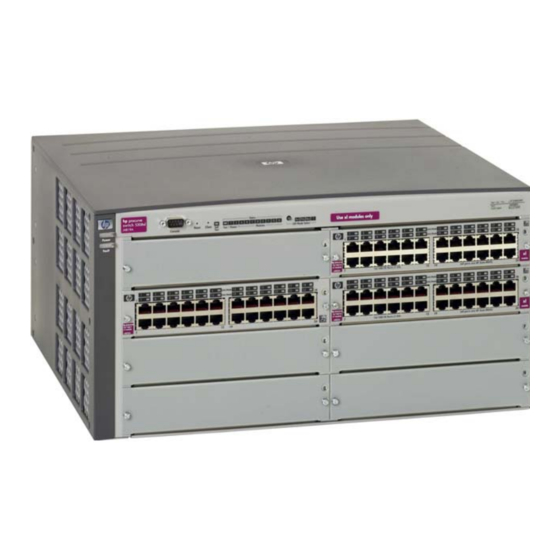HP 5300 İnceleme El Kitabı - Sayfa 25
Anahtar HP 5300 için çevrimiçi göz atın veya pdf İnceleme El Kitabı indirin. HP 5300 35 sayfaları. Hp compaq presario,presario 5300: supplementary guide
Ayrıca HP 5300 için: Tamamlayıcı Kılavuz (7 sayfalar)

HP ProCurve Switch 5300xl Series Reviewer's Guide
To avoid this situation the HP ProCurve Switch 5300 Series uses the source and destination IP
addresses to determine which link a particular packet flow uses. This will provide a good overall
distribution of traffic across the different links in the trunk.
2.6.2 VLANs
A Virtual LAN is a logical collection of ports or nodes that belong to a single broadcast/multicast
domain. VLANs were originally devised as a solution to limit the size of any one broadcast domain to
allow scaling of switched environments. With the advent of routing switch solutions, however, use of
VLANs in end user environments is now largely done for network policy or security reasons.
For the HP ProCurve Switch 5300xl Series, VLANs are also used to provide entities to which to attach
the router functionality. All routing in the HP ProCurve Switch 5300xl Series is defined to be between
VLANs.
HP ProCurve Switch 5300xl Series support 256 VLANs (8 default). VLAN membership can be
designated through either a particular port (untagged), or through a 802.1Q tag.
VLANs can overlap on a single port. For example, it may be advantageous to have a server connected
3
through a single port to be a member of two different VLANs
such that two different groups of PCs
can access the same server, but the two groups of PCs cannot talk directly with each other.
2.6.2.1 IEEE 802.1Q VLAN Support
The HP ProCurve Switch 5300xl Series support the IEEE 802.1Q VLAN tagging standard. The
HP ProCurve Switch 5300xl Series can have multiple VLAN traffic streams share a single physical link.
802.1Q also allows interoperability at this level between different vendors in a standards-based way.
End-to-end VLAN designation is also greatly simplified through the 802.1Q tag, particularly if GVRP,
discussed in the next section, is used.
Ports with only a single VLAN designation can be designated as untagged ports. Packets leaving these
ports will not be 802.1Q tagged. VLAN continuity from switch-to-switch must be manually maintained
at each switch if untagged ports are used.
2.6.2.2 GVRP
GVRP—GARP VLAN Registration Protocol is a standard under 802.1Q that provides a facility to
dynamically configure a VLAN on switches throughout a Layer 2 domain when that VLAN has been
statically configured on at least one switch in the domain. The intention with GVRP is to automatically
interconnect a VLAN that is manually configured on two switches that are not contiguous in a Layer 2
domain. This greatly reduces the administrative overhead of having to define VLANs in all the
intermediate switches between two VLAN islands that need to be interconnected. GVRP will also
delete a dynamic VLAN on any switch port that hasn't heard externally from the VLAN in the last
10 seconds.
GVRP is particularly advantageous in environments using 802.1x, network login. In 802.1x, as a user is
authenticated to the switch from the RADIUS server, a VLAN membership can also be indicated. This
allows the network manager to assign a particular user to a particular VLAN to establish the network
services available for that user. For example, when the user logs in they can be placed in their own
VLAN along with the servers and storage that contains the services that user is allowed to have. One of
the advantages of 802.1x is the ability for the user to login anywhere in the network. If they are
assigned to a VLAN that also has services members, that VLAN will have to be defined all along the
path between the user and those services. GVRP will automatically do this. GVRP will also delete that
VLAN along the path once it is no longer needed.
The HP ProCurve Switch 5300xl Series has a configuration default of 8 VLANs maximum that can be
defined. If GVRP is enabled, the 'maximum VLANs to support' value should be configured in most
3
If multiple VLANs to a server are done using 802.1Q, the server must also support 802.1Q tagging.
© Hewlett-Packard Co. 2002, 2003
Rev 1.1 – 2/11/2003
Page 25 of 35
http://www.hp.com/go/hpprocurve
